Author: Ryan Watkins
Compiled by: TechFlow
It is widely believed that apart from Bitcoin and stablecoins, there are no other valuable applications in the industry. It is said that the driving force of the previous cycle was entirely speculative, and there has been almost no progress since the 2022 crash. The industry has become oversaturated with unused infrastructure, and the venture capitalists who have funded this infrastructure may suffer losses due to improper capital allocation.
The latter part of this view is indeed somewhat valid, as the market has begun to punish blind infrastructure investment, and the long-term winners in the crypto economy are emerging. However, the former part, that there are few applications compared to infrastructure and there has been almost no progress since the previous cycle, appears inaccurate when we observe the data.
In fact, the era of applications has arrived, and the revenue of many applications has already surpassed that of the infrastructure. Leading platforms like Ethereum and Solana have a large number of applications that generate tens of millions to hundreds of millions of dollars in revenue annually, with triple-digit percentage growth. However, although these numbers are impressive, the transaction prices of applications are still much lower than those of infrastructure, with the latter having an average revenue multiple of about 300 times that of applications. While infrastructure assets at the center of the smart contract ecosystem, such as ETH and SOL, may maintain a premium as stores of value, non-monetary infrastructure assets such as L2 tokens may see their multiples compressed over time.
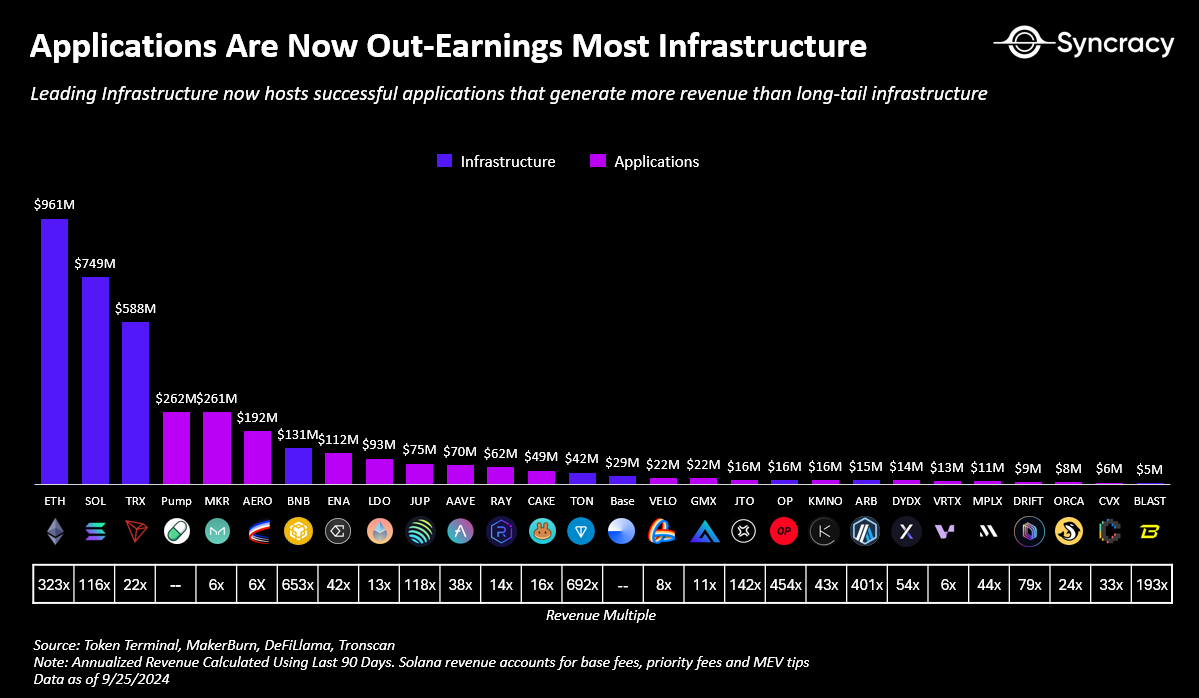
Applications occupy a larger share of the total blockchain fees globally and surpass the revenue of most infrastructure assets, which may mark a turning point in future trends. Data from the two major application ecosystems, Ethereum and Solana, has already shown that applications are gradually capturing a portion of the market share of the underlying platforms in terms of revenue. As applications continue to strive for a greater share of economic benefits and vertically integrate to better control the user experience, this trend may accelerate. Even Solana applications, which pride themselves on their composability, are shifting some operations off-chain, leveraging Layer 2, sidechains, and oracles to achieve scalability.
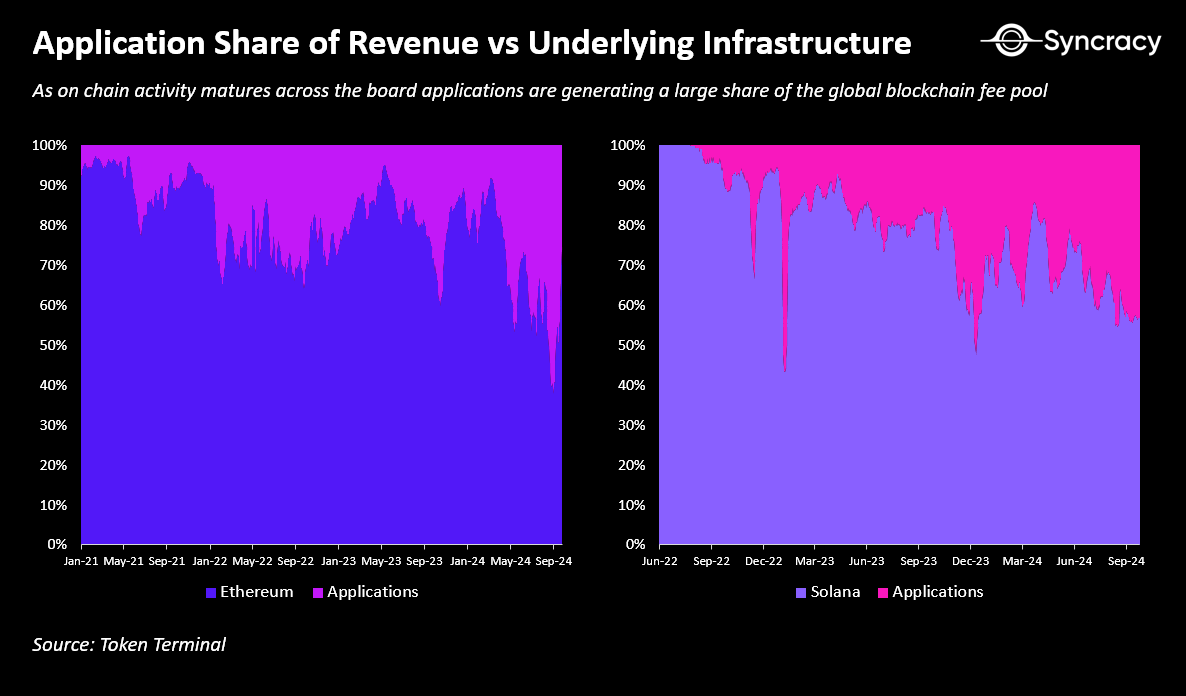
The Rise of Fat Applications
Is the inevitability of rollups assumed? As applications strive to overcome the limitations of a single global state machine in efficiently processing all on-chain transactions, modular cross-blockchain seems inevitable. For example, while Solana has performed exceptionally well in terms of performance, it began to encounter bottlenecks in April this year when only a few million users were transacting memecoins daily. Although Firedancer may help, it is unclear whether it can scale performance to the order of billions of daily active users, including AI agents and enterprises. As mentioned earlier, the modularization process of Solana has already begun.
The key question is to what extent this transformation will occur and how much of the operations will ultimately be shifted off-chain. To run the entire global financial system on a single server - a fundamental assumption of any integrated blockchain - would require full nodes to run in hyperscale data centers, making it virtually impossible for end-users to independently verify the chain's integrity. This would undermine a fundamental feature of globally scalable blockchains, which is to ensure clear property rights and resist manipulation and attacks. In contrast, Rollups allow applications to distribute these bandwidth requirements across independent ordering node sets, while ensuring end-user verification through data availability sampling at the base layer. Furthermore, as applications scale and establish closer connections with users, they may demand greater flexibility from their underlying infrastructure to better meet user needs.
This is already happening on Ethereum, the most mature on-chain economy. Leading applications like Uniswap, Aave, and Maker are actively developing their own Rollups. These applications are not only pursuing scalability, but also driving customized execution environments, alternative economic models (such as native yields), enhanced access control (such as permissioned deployments), and customized transaction ordering mechanisms - features that allow them to enhance user value and reduce operational costs, while gaining greater economic control over their base layer infrastructure. Chain abstraction and smart wallets will make this application-centric world more seamless and gradually reduce friction between different blockchain spaces.
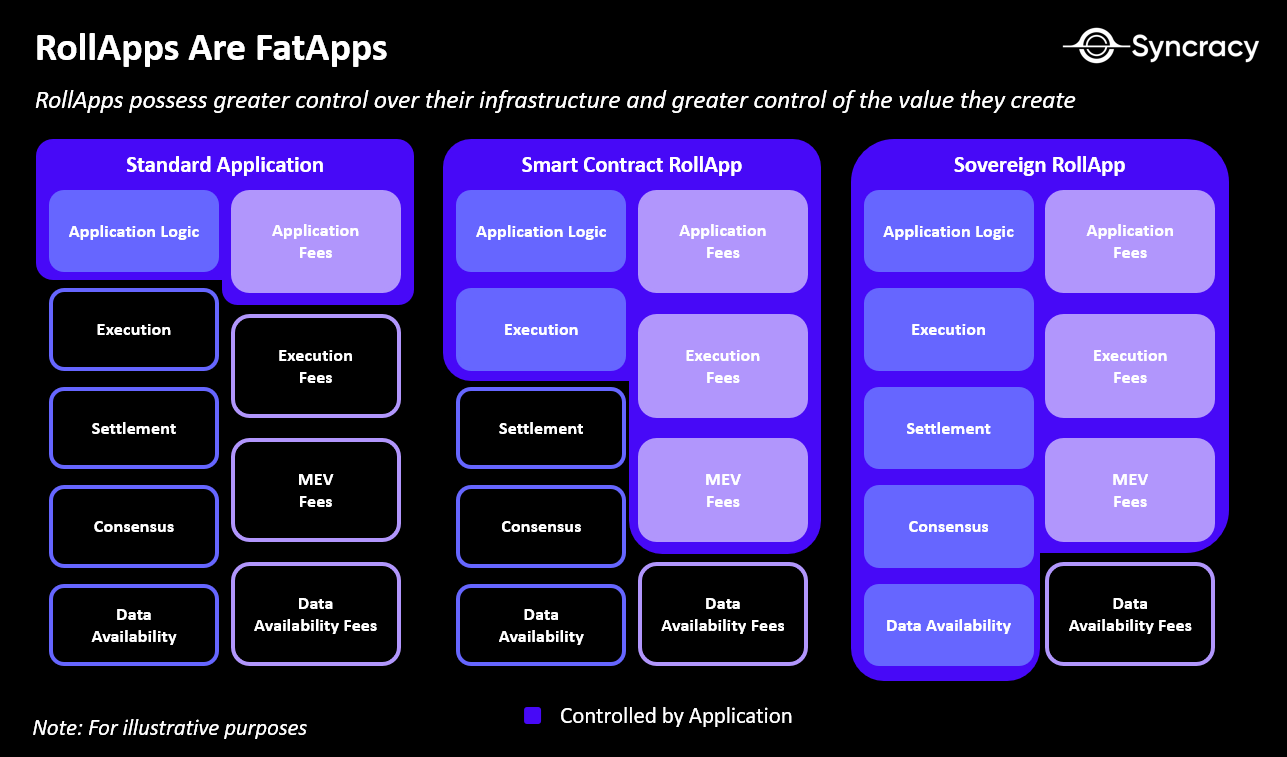
In the short term, next-generation data availability providers like Celestia and Eigen will be key drivers of this trend, providing applications with greater scale, interoperability, and flexibility, while ensuring low-cost verifiability. However, in the long run, every blockchain aspiring to be the foundation of the global financial system will need to scale bandwidth and data availability while ensuring low-cost end-user verification. For example, while Solana is conceptually integrated, teams are already working to achieve lightweight client verification, zk compression, and data availability sampling to achieve this goal.
The focus is not on the specific scaling technologies or blockchain architectures. Token extensions, co-processors, and ephemeral rollups are sufficient to allow integrated blockchains to scale and provide customization for applications without disrupting their atomic composability. Regardless, the future trend points to applications continuing to pursue greater economic control and technical flexibility. The revenue captured by applications exceeding that of their infrastructure seems inevitable.
The Future of Blockchain Value Capture
The next question to focus on is how value will be distributed between applications and infrastructure as applications gradually gain more economic control over the next few years? Will this shift become a turning point, causing applications to have a similar impact to infrastructure in the coming years? According to Syncracy's view, while applications will gradually occupy a larger share of the total blockchain fees globally, infrastructure (L1s) may still generate greater returns for a smaller set of participants.
The core argument of this view is that in the long run, base-layer assets such as BTC, ETH, and SOL will compete as non-sovereign digital stores of value, which is the largest market in the crypto economy. While people often compare Bitcoin to gold and other L1 assets to stocks, this distinction is more narrative-driven. Fundamentally, all native blockchain assets share common characteristics: they are non-sovereign, non-seizurable, and can be digitally transferred across borders. These features are crucial for any blockchain seeking to establish a digital economy independent of state control.
The main difference lies in their global adoption strategies. Bitcoin aims to replace fiat currencies and become the dominant global store of value, directly challenging central banks. In contrast, L1s like Ethereum and Solana are focused on establishing parallel economies in the digital realm, and as they develop, they create natural demand for ETH and SOL. This is already happening. Beyond serving as mediums of exchange (for gas fees) and units of account (for NFT pricing), ETH and SOL are also the primary stores of value within their respective economic ecosystems. As proof-of-stake assets, they directly capture the fees and maximum extractable value (MEV) generated by on-chain activity, and provide the lowest counterparty risk, making them the highest-quality collateral on-chain. In comparison, BTC as a proof-of-work asset does not provide staking or fee earnings, but operates purely as a commodity money.
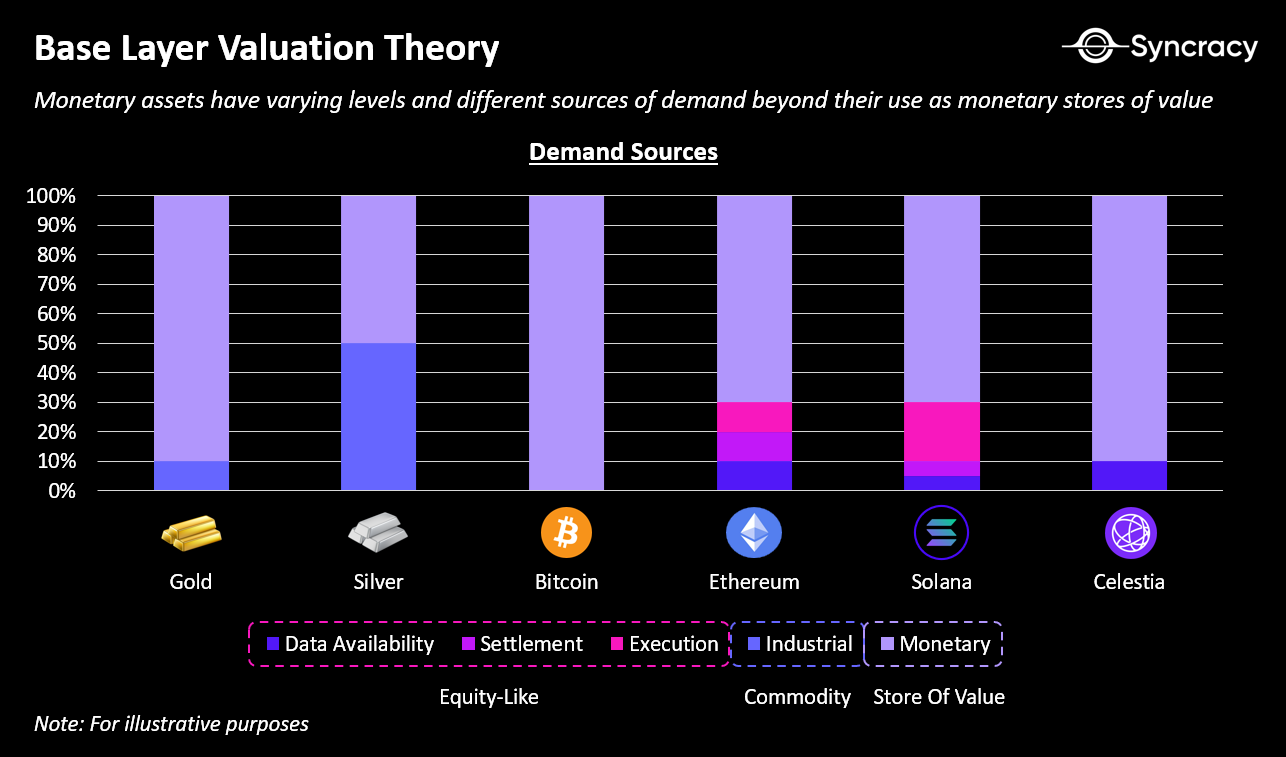
While the parallel economy strategy is highly ambitious, it is unlikely to fully achieve this goal, but may ultimately prove easier to compete alongside national economies rather than directly against them. In fact, Ethereum and Solana's approach is similar to how nations have historically vied for reserve currency status: first establish economic influence, then encourage others to use your currency for trade and investment.
Take MEV as an example, it is unlikely to become a large enough industry to support current valuations, and its proportion in on-chain activity is expected to decrease over time as it gets absorbed more by applications. The closest analogue in traditional finance is high-frequency trading (HFT), with global revenues estimated between $10 billion and $20 billion. Additionally, blockchains may currently be over-capturing MEV, and as wallet infrastructure and order routing improve, MEV revenues may decrease, while applications are also working to internalize and minimize MEV. Can we really expect the MEV revenue of any blockchain to exceed the global HFT industry, and accrue entirely to the validators?
Similarly, while execution and data availability fees are attractive revenue sources, they may still be insufficient to support valuations in the billions or trillions. To achieve this, transaction volumes would need to grow exponentially, while fees remain low enough to drive mainstream adoption, a process that could take a decade.
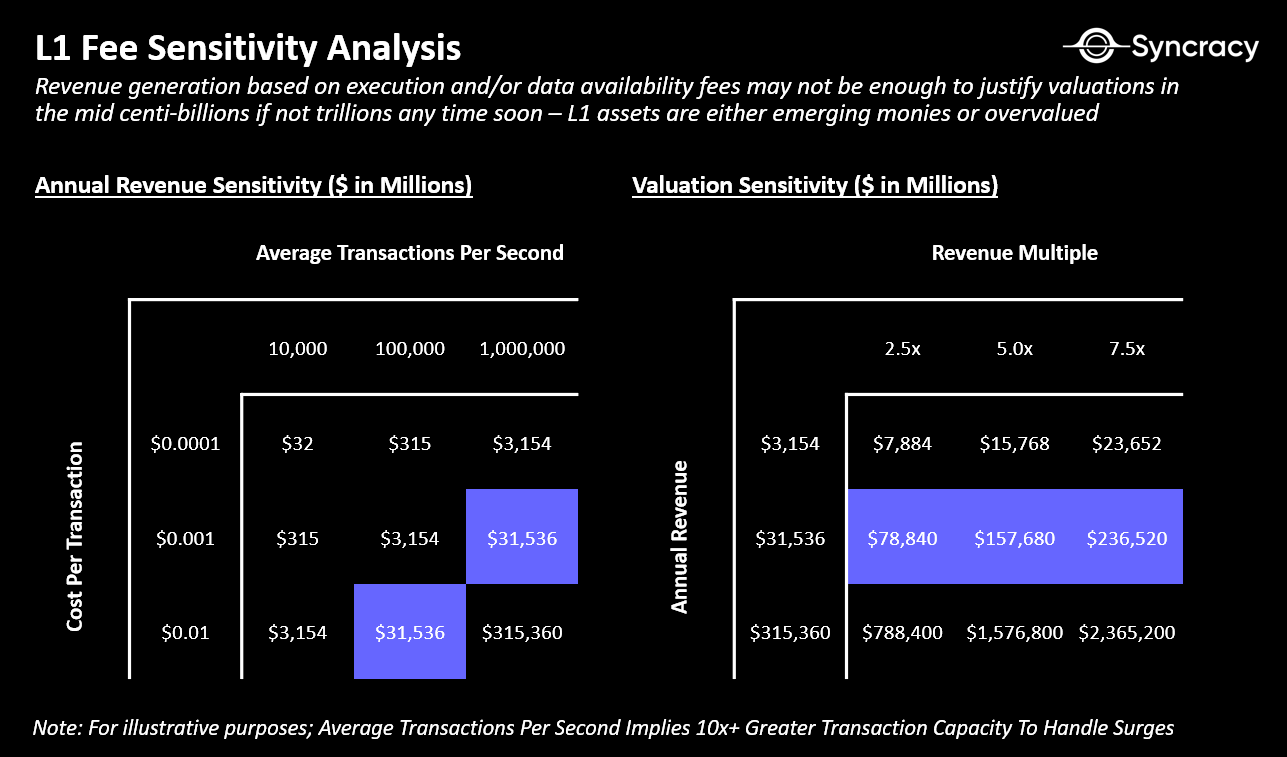
Note: Visa's processing capacity can reach 65,000 tps, but typically averages around 2,000 tps.
So, how can enough value be provided to pay validators to sustain their basic services? Blockchains can offer a perpetual subsidy akin to a tax through monetary inflation, where asset holders gradually lose a small portion of their wealth to subsidize the validators who provide the abundant block space that powers applications, driving the growth of the blockchain's native assets.
A more pessimistic view worth considering is that blockchain valuations should be based on fees, but as applications gain more economic control, these fees may not be able to sustain high valuations long-term. This is not without precedent - during the 1990s internet boom, telecom companies attracted massive infrastructure investment, only for many to become commoditized. While companies like AT&T and Verizon adapted and survived, most of the value accrued to the applications built on top of that infrastructure, such as Google, Amazon, and Facebook. In the crypto economy, this pattern may repeat: blockchains provide the infrastructure, but the application layer captures more of the value. However, in the early stages of the crypto economy, this is still a large relative value competition - BTC aiming to surpass gold, ETH aiming to surpass BTC, and SOL targeting ETH.
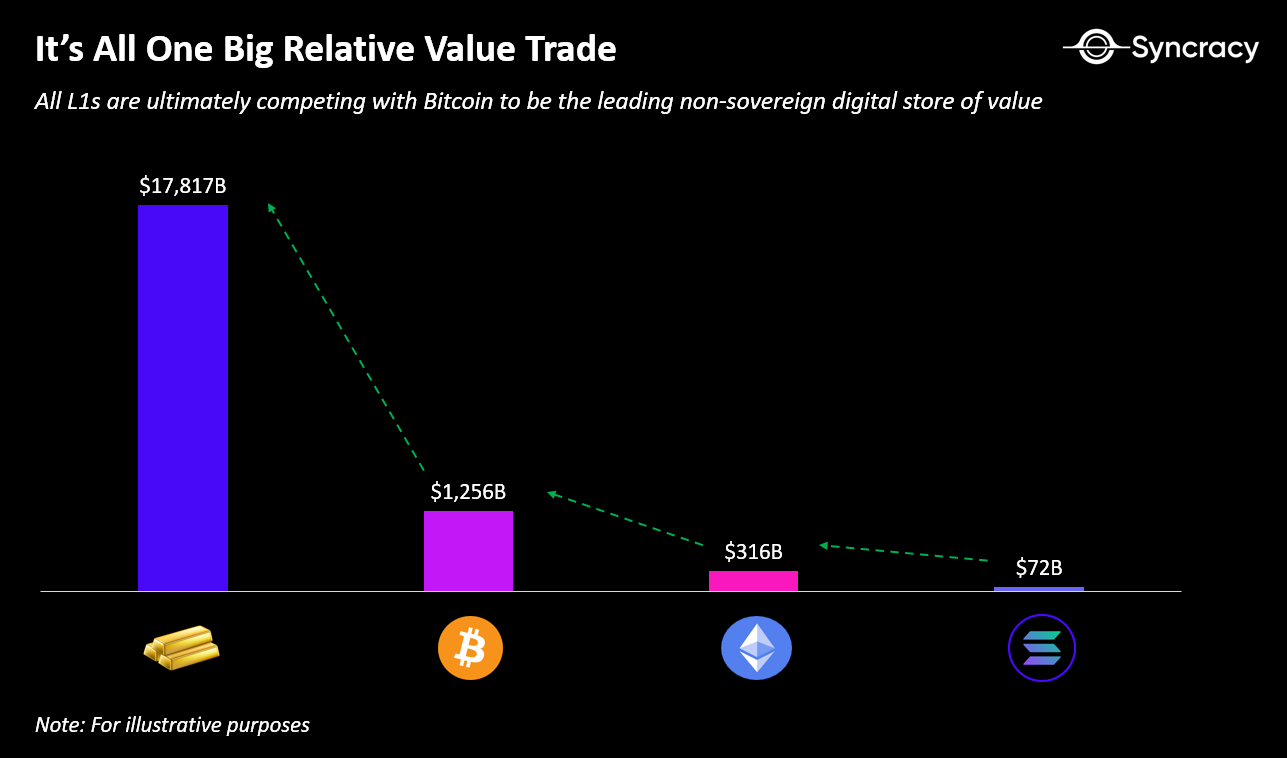
The Application Era, the Crypto Era
Overall, the crypto economy is undergoing a major transition from speculative experimentation to revenue-generating businesses and active on-chain economies, which is bringing real monetary value to blockchain native assets. While current activity may seem small, as the systems scale and user experiences improve, exponential growth is emerging. At Syncracy, we believe that looking back on this period in a few years, it will be interesting to wonder why anyone ever questioned the value of this space, as many important trends have become evident.
The Application Era has arrived, and blockchains will generate more powerful non-sovereign digital stores of value as a result.
Special thanks to Chris Burniske, Logan Jastremski, Mason Nystrom, Jonathan Moore, Rui Shang, and Kel Eleje for their feedback and discussions.








